Carving a beautiful bloom
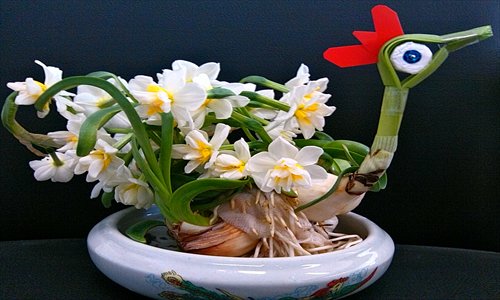
The Chinese sacred lily is a special flower indeed - it brings an end to winter with its delicate white and yellow flowers and special scent. It has a special place in Chinese culture where it is called the "fairy over rippling waters."
It is a tradition for people to take the bulbs of this flower and "force" grow them indoors so that they bloom early. Chinese people consider it especially lucky if the flower blooms during the lunar new year season. They believe an early bloom is a sign of abundance to come.
The Chinese sacred lily belongs to the narcissus or daffodil family and is also known as paperwhite. It has white flowers with orange or yellow centers, and has a unique fragrance unlike most other varieties of daffodils.
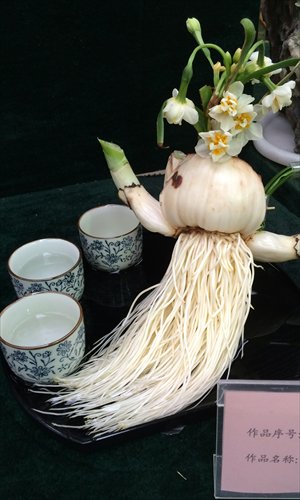
But to "force" the plant to an early bloom the bulbs must be carved expertly. The Shanghai Gongqing Forest Park holds an annual competition, usually during the Spring Festival, where growers compete, showing off their carving skills and their abilities to create different shapes and styles.
Wu Weiyi, an experienced Chinese sacred lily grower, has won several prizes for his pieces at these competitions. Last year he was awarded second prize for creating a Chinese sacred lily shaped like a crane. Wu told the Global Times that the best time to buy Chinese sacred lily bulbs was at the beginning of November when batches of fresh bulbs from Fujian Province in the south part of China arrived at the city garden markets.
To "force" a bulb to grow indoors, it has to be carved. The first step involves peeling the brown skin layers off the bulb, and the second step is to cut a slit, about 2 centimeters above the root and along the base, and then cut another two slits from the top to the base.
Then, carefully and gently, the grower trims some layers off. Experienced growers can tell from the shapes and sizes of the pouches in the bulb the number, size and shape of the flowers that might appear. Care must be taken so that the center of the bulb is not damaged at all in this process.
After the trimming is completed the bulb is placed in a shallow container with water. Some people like to stand the plant among decorative pebbles which help it stand upright.
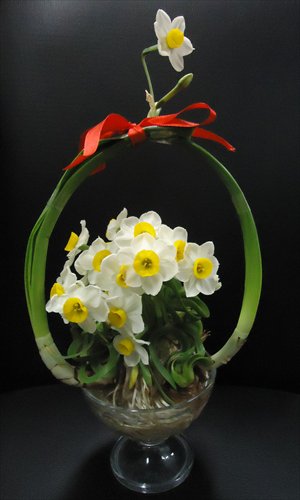
Advanced growers
For many people like Wu the carving and growing of Chinese sacred lily bulbs is an art. Advanced growers can carve a bulb so that the flowers will bloom shaped like kettles, birds or animals.
But traditional sacred lily growers are usually reluctant to reveal their trade secrets. Wu has twice traveled to Zhangzhou, Fujian Province, which is famous for its skilled flower bulb carvers but he never managed to learn anything from them. He gained his skills and expertise from a Shanghai expert and now readily shares his knowledge with anyone who is interested.
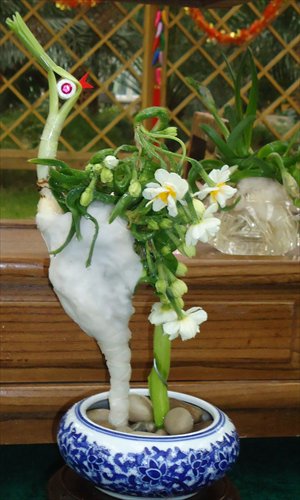
He said, for example, that if a grower wants to make the leaves of the flower curly, he or she will have to cut a third of the leaf growths on the bulb. Care must be taken not to damage the tiny flower buds inside the leaves. To give the stem a curve in a particular direction, a gardener can scratch gently on the right section of the bulb.
In the annual competition, as well as being able to carve skillfully, it is also very important to see how the flowers bloom. Shen Yuanyuan is a senior staff member with the Gongqing Forest Park and said the judges rated the entries according to their health, shape, and blooms.
To have a plant reach its peak and be in good shape for the competition, a gardener needs to pay close attention to the temperature, the amount of sunlight and its water.
After carving Wu said it was better to let a bulb be immersed facedown in water for two days to clean out the liquids from the bulb's cuts. Then the bulb must be put into its container with water covering the lower half. It should be left there for 10 days until the roots start growing out.
Gardeners at this stage keep the water at a level around the base of the bulb so that the leaves don't grow too large - this can mean the leaves absorb much of the nutrition and stunt the growth of the flowers.
After that, the only task remaining is to change the water which should be done every other day at the beginning. But after a month this can be done once each week.
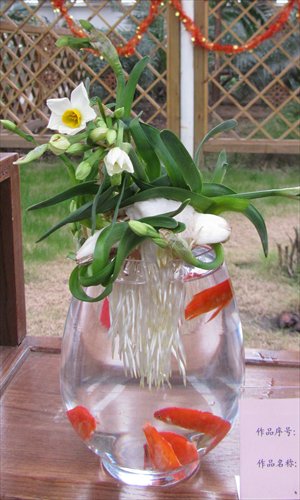
Sunlight ideal
These "forced" Chinese sacred lilies are best kept beside windows and at a room temperature of approximately 10 C. It is ideal if the plant can be left in sunlight for 4 to 5 hours a day. It takes about 60 days for a plant to flower under these conditions.
Lu Haigen is another prizewinning Chinese sacred lily grower and he said it was important to give a plant the correct amount of sunlight. Lu lives in an apartment on the west of Huangpu River but travels every day to his sister's apartment on the east side of the river to tend to his plants there - his sister's home enjoys more direct sunlight.
However sunlight is not always the best thing for these flowers. Lu said that after a plant blooms it should be kept in a shaded area because this will prolong the life of the flowers.
Lu often selects different containers for his sacred lilies, and has used ornate glass vases and seashells. He once grew a lily in a vase with a goldfish - although he had to remove the bulb every time he fed the fish.